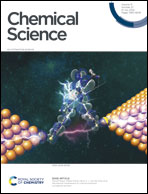Carbon dioxide reduction by an Al–O–P frustrated Lewis pair†
Abstract
The reaction of tBu2P(O)H with Bis2AlH (Bis = CH(SiMe3)2) afforded the adduct tBu2P(H)–O–Al(H)Bis2 (3). It slowly releases H2 to form the first oxygen-bridged geminal Al/P frustrated Lewis pair tBu2P–O–AlBis2. It is capable of reversibly binding molecular hydrogen to afford 3, shown by NMR and H/D scrambling experiments, and forms a 1,2-adduct with CO2. Importantly, the H2 adduct 3 reduces CO2 in a stoichiometric reaction leading to the formic acid adduct tBu2P(H)–O–Al(CO2H)Bis2. The formation of the different species was explored by density functional theory calculations which provide support for the experimental results. All products were characterized by NMR spectroscopy as well as X-ray diffraction experiments and elemental analyses.



 Please wait while we load your content...
Please wait while we load your content...